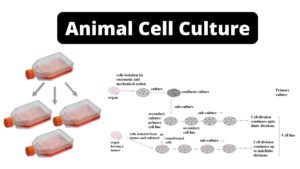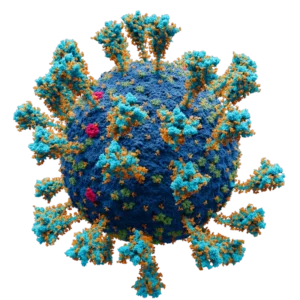Diagnosis of viral infections
- Laboratory diagnosis of viral infections is a complex process. There are present three types of diagnosis methods for a viral infection such as (1) direct detection, (2) indirect examination (virus isolation), and (3) serology.
- The direct method of viral diagnosis is accomplished by observing the viral specimen directly under microscopes, to confirm the presence of virus particles, virus antigen or viral nucleic acids.
- The indirect method is accomplished by growing the viral specimen within a cell culture, eggs, or animals.
- The serological method is accomplished by detecting the rising titers of antibody between acute and convalescent stages of infection, or the detection of IgM. Most of the viruses are detected by using the serology method.
- Before the diagnosis, it’s important to isolate the virus specimen from a proper location. For example, a positive result from the CSF or the brain would be much higher significance than a positive result from an oral ulcer, since reactivation of oral herpes is common during times of stress.
Importance of Viral Diagnosis
The Viral diagnosis will be particularly helpful in different clinical situations such as;
- There are important public health considerations. For example influenza and arbovirus encephalitis, etc.
- There are significant risks to susceptible persons exposed to the patient. For example measles, hepatitis B, and varicella.
- In a situation that involves Important prognostic considerations. For example congenital infections, encephalitis, and infections in immunocompromised hosts.
- In a situation where Withdrawal of antibiotics might serve the patient’s interest. For example respiratory virus infections and viral meningitis such as respiratory virus infections and viral meningitis.
- In a situation where therapeutic action depends on viral diagnosis. For example treatment with an antiviral agent, hospital infection control, and therapeutic abortion for rubella in pregnancy.
- Laboratory diagnosis of viral infections will help medical staff to understand about diseases or epidemiology and improve subsequent care of similar patients.
Diagnosis Methods
1. The Direct Examination of Specimen
- This method gives results within the same day or the next day that is why it is also known as rapid diagnostic methods.
- This method is helpful for diagnosis of RSV infection in neonates, or severe CMV infections in immunocompromised patients.
The direct method is accomplished by these following processes;
- Antigen Detection
- An important example of this method is immunofluorescence testing of nasopharyngeal aspirates for respiratory viruses such as; RSV, flu A, flu B, and adenoviruses, detection of rotavirus antigen in feces, the pp65 CMV antigenemia test, the detection of HSV and VZV in skin scrapings, and the detection of HBsAg in serum.
- This test gives a result within a few hours.
- Sometimes this method becomes tedious and time-consuming, the result difficult to read and interpret, and the sensitivity and specificity poor.
- The specimen quality also plays an important role for the test to work properly.
- Electron Microscopy
- This method is used to detect the virus particle based on their morphological characters.
- Approximately 50,000 magnification power has been used in electron microscopes to observe virus particles.
- This method is used for the diagnosis of viral gastroenteritis, which is accomplished by detecting the virus particles in feces, for example, rotavirus, adenovirus, astrovirus, calicivirus, and Norwalk-like viruses.
- Often EM is used to detect virus particles on vesicles and other skin lesions, such as herpesviruses and papillomaviruses.
- The immune electron microscopy can be used to increase the sensitivity and specificity of Electron Microscopy. This method is accomplished by performing an agglutination reaction between a virus-specific antibody and virus particles, thus making them easier to recognize or by using an EM grid where the virus particles are captured.
- The main disadvantage of this method is, it is expensive to purchase and the maintenance cost is high.
- Often it provides poor sensitivity, with at least 10^5 to 10^6 virus particles per ml in the specimen sample is needed for visualization.
- Required highly skilled observers to observe virus particles within EM.
- Light Microscopy
- Viral Genome Detection
- In this method, molecular techniques or methods are used for the detection of the viral particles.
- Examples of classical molecular techniques are dot-blot and Southern-blot.
- Newly developed molecular techniques include polymerase chain reaction (PCR), ligase chain reaction (LCR), nucleic acid-based amplification (NASBA), and branched DNA (bDNA) depending on some form of amplification.
- Among these techniques most widely used method is PCR, it is an extremely sensitive technique
2. Indirect Method or cell cultures (Virus Isolation)
- For the isolation of viral particles Cell cultures, eggs, and animals can be used. But most virologists use cell culture for isolation because eggs and animals are difficult to handle.
- There are present three types of cell culture such as Primary cells, Semi-continuous cells, and Continuous cells.
- The Primary cell culture is widely used and most expensive. An example of Primary cell culture is Monkey Kidney. These are obtained from freshly killed adult animals. Primary cells can only be passed once or twice.
- The example of semi-continuous cell culture is Human embryonic kidney and skin fibroblasts. These are collected from embryonic tissue, and maybe passed up to 50 times.
- The example of Continuous cell culture is HeLa, Vero, Hep2, LLC-MK2, BGM. Continuous cells are immortalized cells for example tumor cell lines and may pass indefinitely.
- The presence of a growing virus on cell culture can be detected by observing the Cytopathic Effect (CPE), Haemadsorption.
The Cytopathic Effect (CPE) is present in both HSV and CMV and absent in enteroviruses. In Hemadsorption the cell is stuck to mammalian red blood cells. This method only helps in the detection of influenza and parainfluenza viruses.
- The virus particle identity can be confirmed by using neutralization, hemadsorption- inhibition, immunofluorescence, or molecular tests.
The disadvantages in cell culture
- Required a long period (up to 4 weeks) for the result.
- The sensitivity of this method is poor because it depends on some essential factors such as the condition of the specimen and the condition of the cell sheet.
- Chances of bacterial contamination and toxic substances in the specimen.
- Hepatitis B and C, Diarrhoeal viruses, parvovirus don’t grow in cell culture.
3. Serology
- During the primary humoral immune response to an antigen when the host is exposed to an antigen it produces the first antibody known as IgM.
- The IgM is followed by a much higher titer of IgG. During the reinfection, the IgM level either remains the same or rises slightly.
- The presence of Igm and IgG antibody can be detected by performing several serological tests such as Complement fixation tests (CFT), Haemagglutination inhibition tests, Immunofluorescence techniques (IF), Neutralization tests, Single Radial Haemolysis.
- Newly developed serological techniques include Radioimmunoassay (RIA), Enzyme linked immunosorbent assay (EIA), Particle agglutination, Western Blot (WB), Recombinant immunoblot assay (RIBA), line immunoassay (Liatek), etc.
Criteria for diagnosing Primary Infection
- Detection of IgM
- The presence of IgM can be detected by several serological tests such as EIA, RIA, and IF.
- However, there are present several limitation in IgM detection such as rheumatoid factor can interfere, re-infection can be occurs by the virus, and unexplained persistence of IgM years after the primary infection
- Seroconversion
- When an antibody transforms from a negative state to a positive state it is referred to as Seroconversion. For example; seroconversion against HIV following a needle-stick injury, or against rubella following contact with a known case.
- A single high titre of IgG or total antibody
- This is a very unreliable means of serological diagnosis since the cut-off is very difficult to define.
- A significant rise in titre of IgG/total antibody between acute and convalescent sera
Limitations of serological diagnosis
- Require a long period of time for diagnosis for paired acute and convalescent sera.
- Some mild local infections do not produce a detectable humoral immune response such as HSV genitalis.
- A false positive result can be generated if antigenic cross-reactivity occurs between related viruses such as HSV and VZV, Japanese B encephalitis and Dengue.
- A reduced or absent humoral immune response is often found in immunocompromised patients.
- A false positive result can be generated for those patients who have infectious mononucleosis and those with connective tissue diseases such as SLE.
- A false positive result can be generated from Patients given blood or blood products due to the transfer of antibodies.
- The Serological diagnosis would be retrospective and therefore will not be that useful for those viruses that often produce clinical disease before the appearance of antibodies such as respiratory and diarrhoeal viruses.



